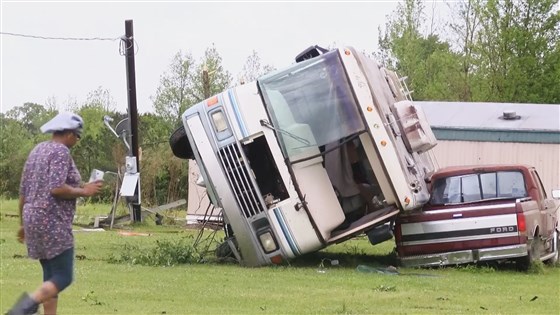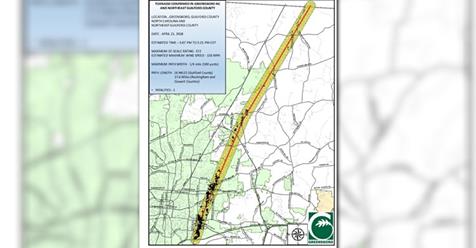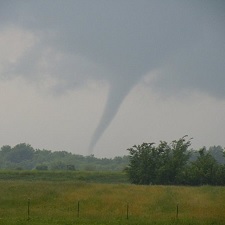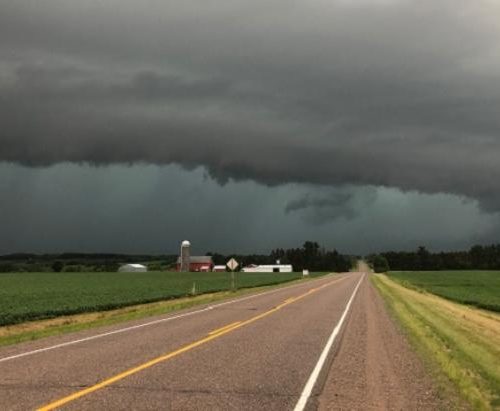At least 16 people were killed after tornadoes began ripping through the South on Easter, destroying homes and storefronts and leaving over 1 million people without power from an intense storm system now headed towards the Mid-Atlantic.
Tornadoes and severe weather hit Central Texas early Sunday, bringing “gigantic” hail and damage, and then traveled east through Louisiana, Arkansas, Mississippi, Tennessee, Alabama, Georgia, and the Carolinas.
In Mississippi, the state’s emergency management agency said 11 people died in at least three different counties near the Louisiana border — Walthall, Lawrence and Jefferson Davis — from the weather.
Five more lost their lives in Murray County, Georgia, the fire chief Dewayne Bain told NBC News on Monday morning. The rural county, an hour outside Chattanooga, Tennessee, was hit hard, and four of the five who died were found in a local trailer park. The other fatality was brought to the emergency room before succumbing to injuries, and five more people were injured, Bain said. In Chattanooga, police deployed at least 26 teams of four to six officers to check on residents who requested emergency assistance after the storm.
The governors of Mississippi, Louisiana and Alabama each declared states of emergency to help recover from the damage caused by the storms, as 41 tornadoes were reported in the past 24 hours.
On Monday morning, severe thunderstorms capable of damaging winds, tornadoes, and hail continued in northern Florida, Virginia and the Carolinas, where two tornado watches are in place until noon. Forty million people across the Eastern seaboard are at risk for severe storms, from New Jersey to Florida as heavy rains up to New England will continue until Monday evening. More than 160 million people are under wind alerts in almost every state east of the Mississippi River.
As emergency crews continue to sort through the wreckage, Mississippi officials have not released more information on the deceased, but the Lawrence County Sheriff’s Office announced late Sunday that one of its deputies, Robert Ainsworth, and his wife were among the dead.
“Robert left this world a hero, as he shielded Mrs. Paula during the tornado,” the department said in a statement on its Facebook page. “He was a very valuable employee and will be greatly missed.”
The storms, which have now left more than one million people without power across the Southeast according to an outage tracking website, come as the states hit by the storms are dealing with the coronavirus pandemic.
In Louisiana, one of the places hit hardest by the virus, Monroe, a small city in the northern part of the state, had to close its airport after storms caused extensive damage to the facility. Gov. John Bel Edwards asked Louisiana residents to remain at home as severe weather continues through the state on Sunday and as over cases of the virus soared past 20,000.
In Alabama, the National Weather Service’s Birmingham division acknowledged the difficulty of grappling with two separate dangers.
“The decision to seek shelter in a community storm shelter is certainly made more difficult by the consideration for COVID-19, and each individual will need to make an educated decision on where and when to shelter from a tornado,” the agency wrote in a joint statement with the Alabama Department of Public Health on March 22.
The two agencies recommended residents make protecting themselves from a potential tornado their “first priority.”
“If a [tornado] warning is issued for your area, you are more likely to be affected by the tornado than the virus,” the statement read.
Alabama’s Governor Kay Ivey suspended some stay-at-home orders in the state, saying that shelters and community safe rooms needed to stay open so that all individuals could seek refuge while “implementing reasonable practices and procedures” to prevent spreading COVID-19.
In Starkville, Mississippi, families tried to practice social distancing as they crowded into an emergency shelter. The state’s emergency management system asked those sheltering to “please wear a mask, bandana, or scarf” around their face and keep their distance from others.
When more than 20 people were injured after a tornado hit Jonesboro, Arkansas, on March 28, mayor said shelter-in-place guidances might have actually saved lives, as less people were out on the roads and in stores when the tornado hit.
How residents will deal with protecting themselves from dual dangers is on the minds of government officials throughout the Mid-Atlantic and the Northeast as the storm travels north on Monday.
New York Gov. Andrew Cuomo urged residents in the western region of the state to take precautions Sunday as they brace for a storm system expected to bring high winds and rains until Tuesday. Cuomo said the storm could cause flooding and power failures in the state hardest hit by the pandemic, with over 180,000 cases of coronavirus, including 8,627 deaths, as of Sunday.
In New York City, a coronavirus field hospital in Central Park with a wind threshold of 65 miles per hour might see its limits tested after a high wind warning was issued and forecasts show the city might see winds of over 60 miles per hour.
CORRECTION (April 13, 2020, 8:45 a.m.): An earlier version of this article misstated when a tornado struck Jonesboro, Arkansas. It was March 28, not Sunday.
by Ben Kesslen (2020, Apr 13) NBC News





